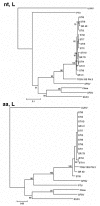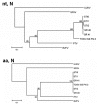Toscana virus in Spain
- PMID: 16318721
- PMCID: PMC3367369
- DOI: 10.3201/eid1111.050851
Toscana virus in Spain
Abstract
Toscana virus (TOSV, Phlebovirus, family Bunyaviridae) infection is one of the most prevalent arboviruses in Spain. Within the objectives of a multidisciplinary network, a study on the epidemiology of TOSV was conducted in Granada, in southern Spain. The overall seroprevalence rate was 24.9%, significantly increasing with age. TOSV was detected in 3 of 103 sandfly pools by viral culture or reverse transcription-polymerase chain reaction from a region of the L gene. Nucleotide sequence homology was 99%-100% in TOSV from vectors and patients and 80%-81% compared to the Italian strain ISS Phl.3. Sequencing of the N gene of TOSV isolates from patients and vectors indicated 87%-88% and 100% homology at the nucleotide and amino acid levels, respectively, compared to the Italian strain. These findings demonstrate the circulation of at least 2 different lineages of TOSV in the Mediterranean basin, the Italian lineage and the Spanish lineage.
Figures



References
-
- West Nile virus. Division of vector-borne infectious diseases. Centers for Disease Control and Prevention, 2005. [cited 2005 Feb 3]. Available from http://www.cdc.gov/ncidod/dvbid/westnile
-
- Mailles A, Dellamonica P, Zeller H, Durand JP, Zientara S, Goffette R, et al. Human and equine West Nile virus infections in France, August–September 2003. Eurosurveillance Weekly 2003; 7 [cited 2005 Mar 22]. Available from http://www.eurosurveillance.org/ew/2003/031023.asp
-
- Connell J, McKeown P, Garvey P, Cotter S, Conway A, O'Flanagan D, et al. Two linked cases of West Nile virus (WNV) acquired by Irish tourists in the Algarve, Portugal. Eurosurveillance Weekly 2004; 8 [cited 2005 Mar 22]. Available from http://www.eurosurveillance.org/ew/2004/040805.asp
-
- Stefanoff P, Eidson M, Morse DL, Ziellinski A. Evaluation of tickborne encephalitis classification in Polland. Eurosurveillance Weekly 2005; 10 [cited 2005 Mar 22]. Available from http://www.eurosurveillance.org/em/v10n01/1001-225.asp - PubMed
Publication types
MeSH terms
Substances
LinkOut - more resources
Full Text Sources
Molecular Biology Databases
